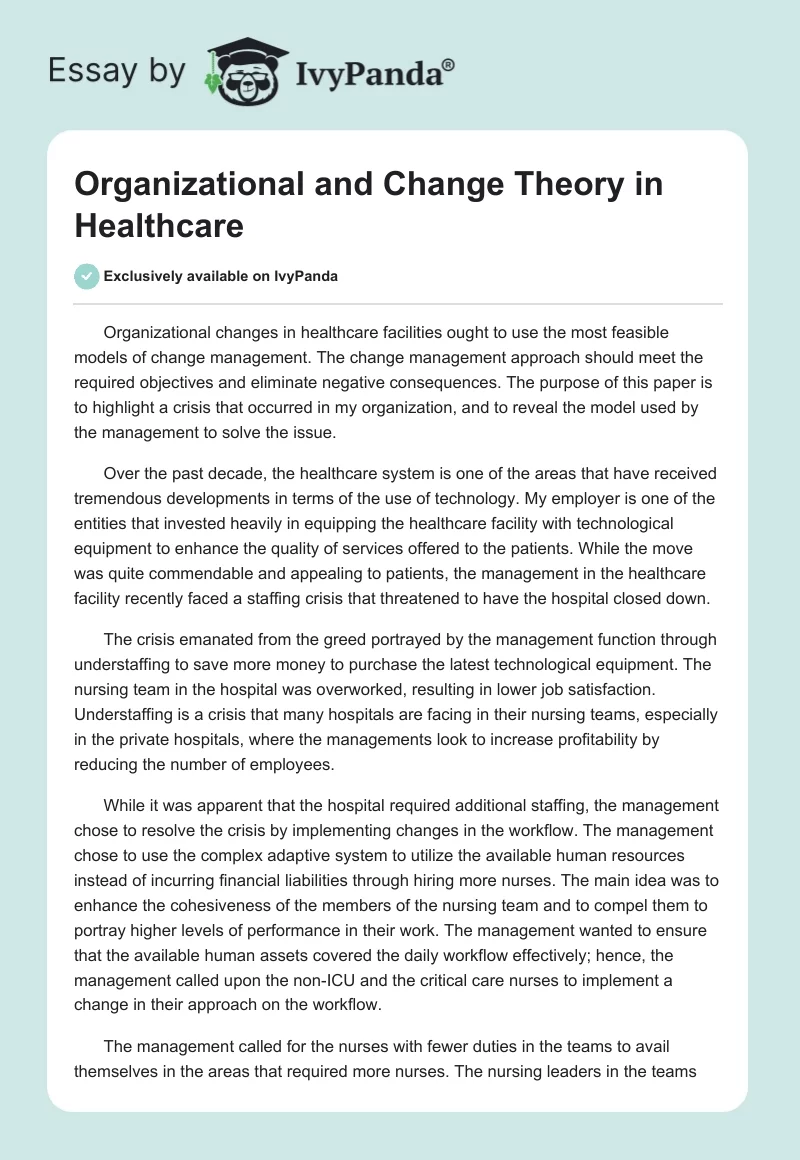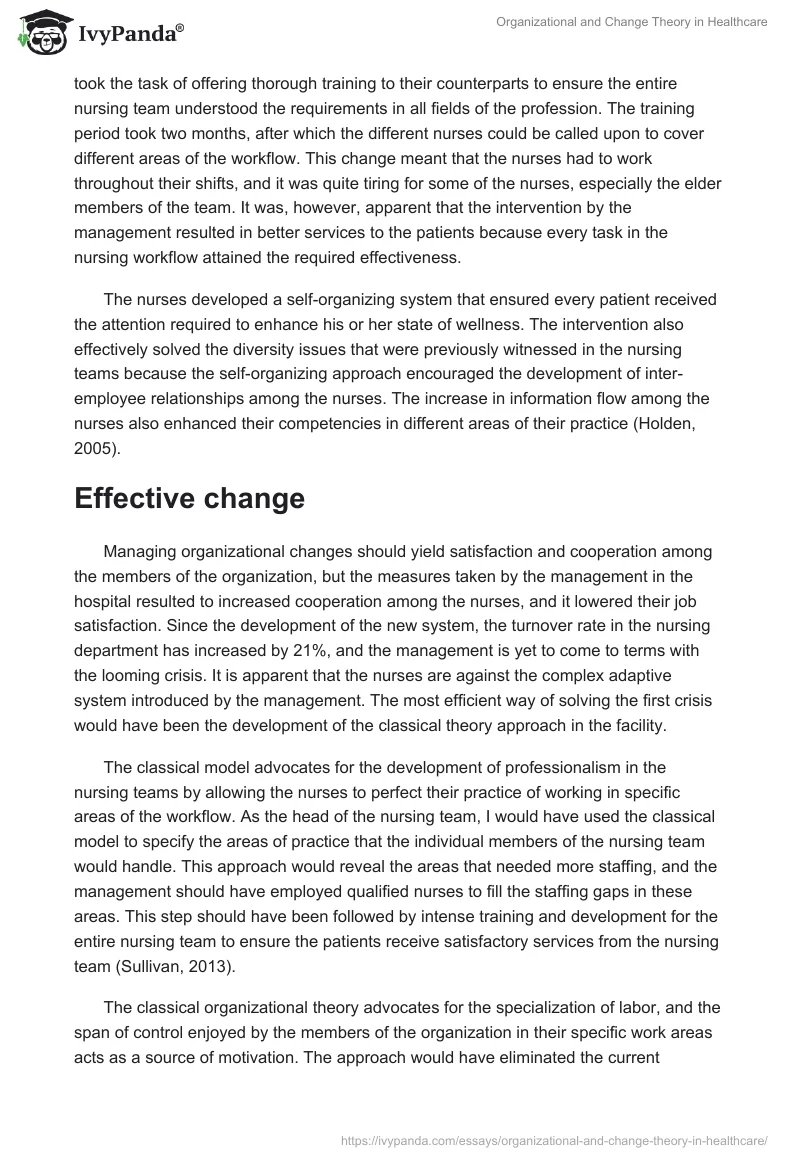Organizational changes in healthcare facilities ought to use the most feasible models of change management. The change management approach should meet the required objectives and eliminate negative consequences. The purpose of this paper is to highlight a crisis that occurred in my organization, and to reveal the model used by the management to solve the issue.
Over the past decade, the healthcare system is one of the areas that have received tremendous developments in terms of the use of technology. My employer is one of the entities that invested heavily in equipping the healthcare facility with technological equipment to enhance the quality of services offered to the patients. While the move was quite commendable and appealing to patients, the management in the healthcare facility recently faced a staffing crisis that threatened to have the hospital closed down.
The crisis emanated from the greed portrayed by the management function through understaffing to save more money to purchase the latest technological equipment. The nursing team in the hospital was overworked, resulting in lower job satisfaction. Understaffing is a crisis that many hospitals are facing in their nursing teams, especially in the private hospitals, where the managements look to increase profitability by reducing the number of employees.
While it was apparent that the hospital required additional staffing, the management chose to resolve the crisis by implementing changes in the workflow. The management chose to use the complex adaptive system to utilize the available human resources instead of incurring financial liabilities through hiring more nurses. The main idea was to enhance the cohesiveness of the members of the nursing team and to compel them to portray higher levels of performance in their work. The management wanted to ensure that the available human assets covered the daily workflow effectively; hence, the management called upon the non-ICU and the critical care nurses to implement a change in their approach on the workflow.
The management called for the nurses with fewer duties in the teams to avail themselves in the areas that required more nurses. The nursing leaders in the teams took the task of offering thorough training to their counterparts to ensure the entire nursing team understood the requirements in all fields of the profession. The training period took two months, after which the different nurses could be called upon to cover different areas of the workflow. This change meant that the nurses had to work throughout their shifts, and it was quite tiring for some of the nurses, especially the elder members of the team. It was, however, apparent that the intervention by the management resulted in better services to the patients because every task in the nursing workflow attained the required effectiveness.
The nurses developed a self-organizing system that ensured every patient received the attention required to enhance his or her state of wellness. The intervention also effectively solved the diversity issues that were previously witnessed in the nursing teams because the self-organizing approach encouraged the development of inter-employee relationships among the nurses. The increase in information flow among the nurses also enhanced their competencies in different areas of their practice (Holden, 2005).
Effective change
Managing organizational changes should yield satisfaction and cooperation among the members of the organization, but the measures taken by the management in the hospital resulted to increased cooperation among the nurses, and it lowered their job satisfaction. Since the development of the new system, the turnover rate in the nursing department has increased by 21%, and the management is yet to come to terms with the looming crisis. It is apparent that the nurses are against the complex adaptive system introduced by the management. The most efficient way of solving the first crisis would have been the development of the classical theory approach in the facility.
The classical model advocates for the development of professionalism in the nursing teams by allowing the nurses to perfect their practice of working in specific areas of the workflow. As the head of the nursing team, I would have used the classical model to specify the areas of practice that the individual members of the nursing team would handle. This approach would reveal the areas that needed more staffing, and the management should have employed qualified nurses to fill the staffing gaps in these areas. This step should have been followed by intense training and development for the entire nursing team to ensure the patients receive satisfactory services from the nursing team (Sullivan, 2013).
The classical organizational theory advocates for the specialization of labor, and the span of control enjoyed by the members of the organization in their specific work areas acts as a source of motivation. The approach would have eliminated the current turnover crisis because it yields competence and satisfaction in the employees, which is essential for services offered to the patients (Larson, 2013).
Summary
The changes assumed by the healthcare facility to solve the understaffing issue followed the complex adaptive system approach, which influences the development of team members acquainted with the skills and knowledge to handle different tasks in the workflow. Its effectiveness lies in the ability to develop a workforce with high creativity in innovating adaptive systems to deliver the required results, but it is apparent that it failed to motivate the nurses in the facility. The best approach would have been using the classical organizational model that entails specialization in labor.
References
Holden. L. M. (2005). Complex adaptive systems: concept analysis. Journal of Advanced Nursing, 52(6), 651-657.
Larson, J. (2013). Why Nurses’ Job Satisfaction Matters to Patients. Web.
Sullivan, E. J. (2013). Effective leadership and management in nursing. (8th ed.). Upper Saddle River: Pearson Prentice Hall.



